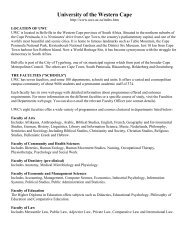UNIVERSITY OF BOTSWANA - Home
UNIVERSITY OF BOTSWANA - Home
UNIVERSITY OF BOTSWANA - Home
Create successful ePaper yourself
Turn your PDF publications into a flip-book with our unique Google optimized e-Paper software.
eliable rainfall than the rest of the country (except Bobirwa, which is about dry as Kgalagadi); indeed the<br />
natural fertility and agricultural potential of the soils, while still low, are greater than in the Kalahari sandveld.<br />
The Kalahari Desert stretches west of the eastern hardveld, covering 84% of the country. The Kalahari extends<br />
far beyond Botswana's western borders, covering substantial parts of South Africa, Namibia and Angola.<br />
“Desert”, however, is a misnomer: its earliest travellers defined it as a 'thirstland'. Most of the Kalahari (or<br />
Kgalagadi, which is its Setswana name) is covered with vegetation<br />
including stunted thorn and scrub bush, trees and grasslands. The<br />
largely unchanging flat terrain is occasionally interrupted by gently<br />
descending valleys, sand dunes, large numbers of pans and, in the<br />
extreme northwest, isolated hills, such as Aha, Tsodilo, Koanaka and<br />
Gcwihaba. Many of the pans have dune systems on the southwest side,<br />
which vary in size and complexity. The pans fill with water during the<br />
rainy season and their hard surface layer ensures that the water<br />
remains in the pans and is not immediately absorbed. These pans are<br />
of great importance to wildlife, which obtain valuable nutrients from<br />
the salts and the grasses of the pans.<br />
The Central Market, Gabarone<br />
In the north-west, the Okavango River flows in from the highlands of<br />
Angola and soaks into the sands, forming the 15,000 sq. km network<br />
of water channels, lagoons, swamps and islands. The Okavango is the<br />
largest inland delta system in the world a bit smaller than Isreal or half<br />
of Switzerland. The northeastern region of the Kalahari Basin contains<br />
the Makgadikgadi Pans - an extensive network of salt pans and<br />
ephemeral lakes.<br />
Although Botswana has no mountain ranges to speak of, the almost uniformly flat landscape is punctuated<br />
occasionally by low hills, especially along the southeastern boundary and in the far northwest. Botswana's<br />
highest point is 1,491m Otse Mountain near Lobatse, but the three major peaks of the Tsodilo Hills, in the<br />
country's northwestern corner, are more dramatic.<br />
Climate<br />
Botswana's climate is semi-arid. Though it is hot and dry for much of the year, there is a rainy season, which<br />
runs through the summer months. Rainfall tends to be erratic, unpredictable and highly regional. Often a heavy<br />
downpour may occur in one area while 10 or 15 kilometres away there is no rain at all. Showers are often<br />
followed by strong sunshine so that a good deal of the rainfall does not penetrate the ground but is lost to<br />
evaporation and transpiration.<br />
'Pula', one of the most frequently heard words in Botswana, is not only the name of Botswana's currency, but<br />
also the Setswana word for rain. So much of what takes place in Botswana relies on this essential, frequently<br />
scarce commodity.<br />
Currency<br />
Botswana's unit of currency is the Pula (P), which is divided into 100 Thebe (t). The word 'Pula' means rain and<br />
'thebe' means shield. The shield appears on the national coat of arms. Bank notes come in denominations of<br />
P10, 20, 50 and 100, and coins in denominations of 5t, 10t, 25t, 50t, P1, P2 and P5. Major credit cards,<br />
including Visa, MasterCard, American Express and Diners Club, are accepted widely. Most hotels and lodges<br />
accept foreign currency or travellers' cheques.<br />
9



